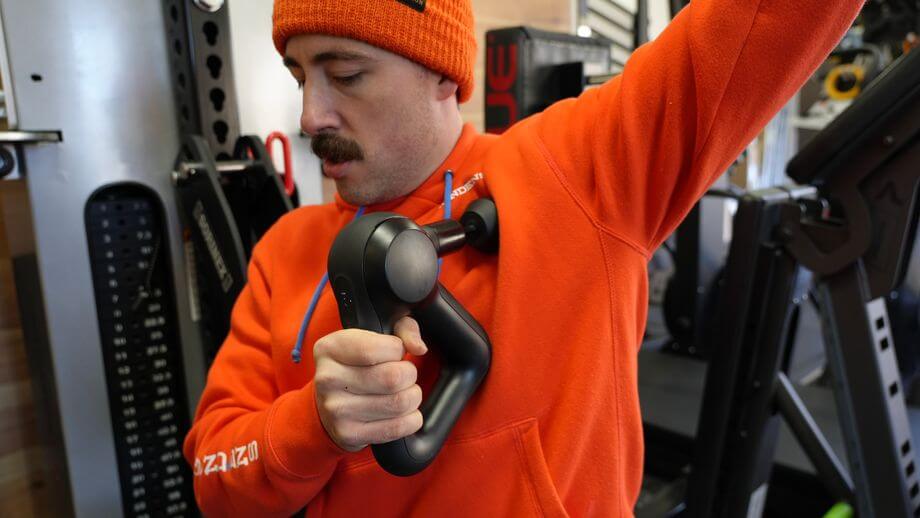We test and review fitness products based on an independent, multi-point methodology. If you use our links to purchase something, we may earn a commission. Read our disclosures.
Once upon a time, when I was a wee fitness newb, I used to smash a hard workout and just hope for the best afterward. Cooldown? Didn’t know her.
Several years later, if I’m skipping recovery, it’s probably because there’s an emergency of some sort (or it’s Friday and I’m gonna be late to happy hour…).
I’m so glad I learned about the importance of workout recovery, and more importantly, what’s beneficial and what’s pointless. Because with the right gear, which I’ll discuss in this guide to the best workout recovery tools—you might start to enjoy your cooldowns and rest days, too.
Why You Should Trust Us
I don’t claim to be an expert at many things, but I do know a thing or two about the dreaded delayed-onset muscle soreness (DOMS) and post-workout recovery products. I’ve tested dozens upon dozens of massage guns, foam rollers, muscle rubs, and other products under this umbrella; and, I’ve interviewed many experts in this space, from physical therapists to the former CEO of NormaTec Recovery.
Best Muscle Recovery Tools of 2024
- Best Massage Gun: Theragun Prime
- Best Compression Boots: Hyperice NormaTec 2.0 Recovery Boots
- Best Foam Roller: TriggerPoint Grid 13” Foam Roller
- Best Vibrating Foam Roller: Theragun WAVE
- Best Foot Roller: Power Plate DualSphere
- Best Electric Muscle Stimulator: Compex 2.0
- Best Muscle Rub: Tiger Balm
- Best Recovery Tool for Runners: Dimple Ball
Best Massage Gun: Theragun Prime
Good for: People who want a deep-tissue massage whenever they need it.
Best Massage Gun
Theragun Prime
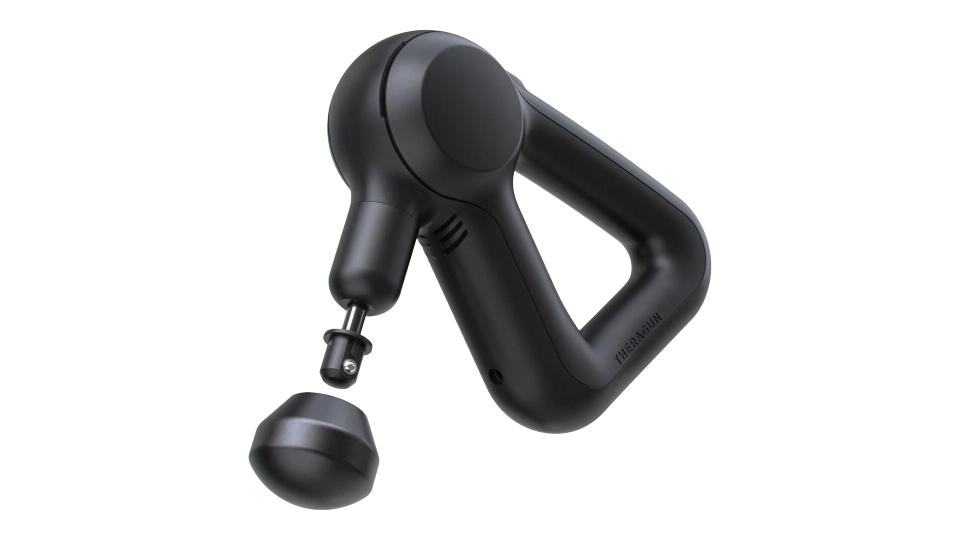
Product Highlights
- Customizable speed ranges
- Ergonomic multi-grip handle makes it easy to massage your back
- High-end product with a reasonable price
Pros & Cons
Pros
- Provides deep tissue treatment reaching 16 millimeters into soft tissue
- Customizable speed ranges
- Ergonomic multi-grip handle makes it easy to massage your back
Cons
- Not the most portable massage gun
- Quieter than previous Theraguns, but still not the quietest option
- Heavy in hand compared to others
Bottom Line
We recommend the Theragun Prime as the best overall massage gun for people who want powerful percussion without an exorbitant price tag.
I’ve tested many Theragun models over the last several years, starting with the brand’s second-generation models that sounded like power drills. Back then, I wouldn’t recommend Theragun because the power wasn’t worth the noise.
Now, though, Therabody has managed to keep the power but minimize the noise, and the Theragun Prime exemplifies craftsmanship and innovation. This massage gun is hands-down the best value when looking at percussive massage devices.
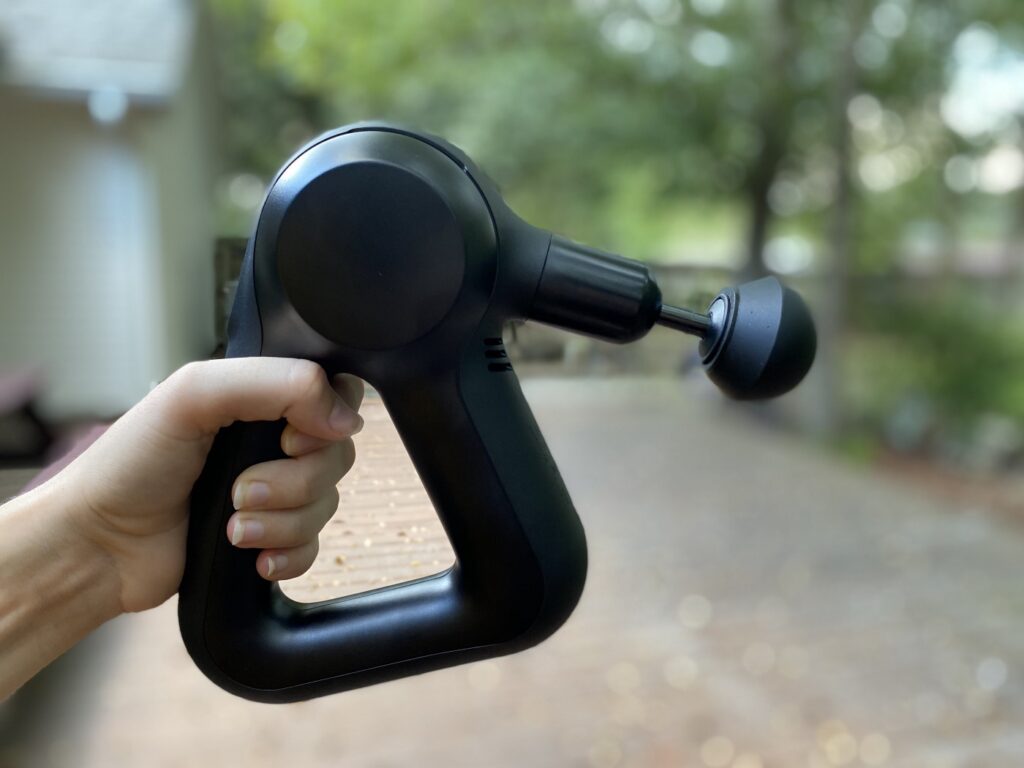
The Prime offers deep-tissue treatment with an impressive 16-millimeter amplitude and 30-pound stall force; it sports a powerful brushless motor with a 2-hour battery life; it features Theragun’s recognizable triangular ergonomic handle; it comes with four dense massage head attachments; and it boasts customizable speed ranges and recovery protocols you can control via the Therabody app.
If you don’t want to use the app, the Theragun Prime has five built-in speeds of 1,750, 1,900, 2,100, 2,200, and 2,400 percussions per minute (PPM).
I won’t call the Prime a budget-friendly massage gun, but if you’re looking for the best combination of features and price, the Prime is the massage gun for you. Therabody does offer financing through Affirm to soften the $300 price tag.
Related: How to Use a Massage Gun the Right Way
Best Compression Boots: Hyperice NormaTec 2.0 Recovery Boots
Good for: People who prefer hands-off recovery and want to enhance blood circulation.
Best Compression Boots
Normatec Pulse Leg Recovery System
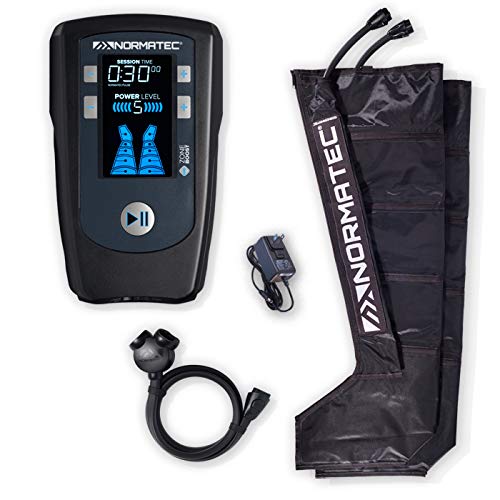
Product Highlights
- 7 levels of compression
- Short, standard, and long boot sizes available
- Carrying case neatly packs away all component
Pros & Cons
Pros
- 7 levels of compression
- Short, standard, and long boot sizes available
- Carrying case neatly packs away all components
Cons
- Big, bulky, and hard to travel with
- Compression measurement (in mmHg) not specified online
- Expensive ($700-900 depending on where you buy)
Bottom Line
A hands-off way to increase blood circulation and improve muscle recovery.
NormaTec compression boots became popular in 2019 when they began appearing in professional and college sports locker rooms and trendy recovery lounges in New York City and Los Angeles.
What began as a medical device company manufacturing pneumatic compression boots to help combat lymphedema, a type of chronic swelling, turned into a fitness craze. When I interviewed the then-CEO of NormaTec, Gilad Jacobs, back in 2019, I learned that the name is actually a tribute to his grandmother Norma. (So sweet!)
Over time, NormaTec began expanding business from the healthcare industry to the sports industry, and today, this computerized massage machine is a popular direct-to-consumer device.
These galactic-looking boots may look odd or complex, they’re actually pretty simple: Simply wiggle into the boots, zip them up, attach the air hose, and set the timer and intensity level. Then, sit back and watch as the four air chambers alternate compressing and decompressing for an air-powered massage.
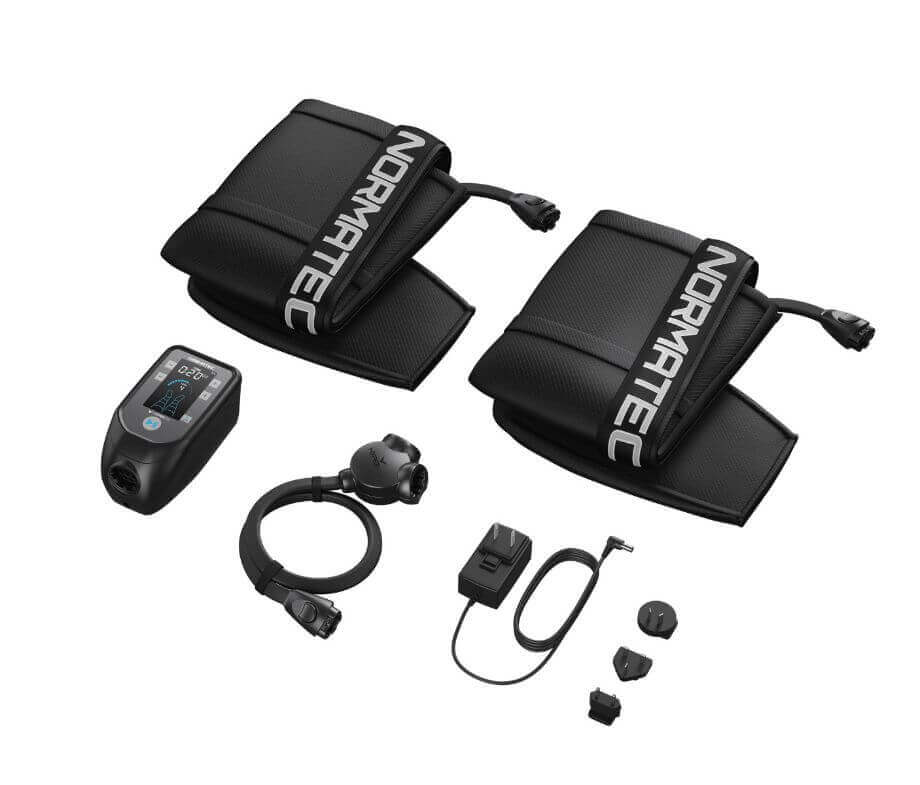
The boots feature seven intensity levels along with “Zone Boost Technology,” which provides extra time and pressure in a particular zone of the legs. You can adjust this through the wired control unit.
Compression is measured in mmHg, or millimeters of mercury, so I attempted to find specs on this for the NormaTec boots. (For example, compression socks or stockings may specify they provide 20-30 mmHg of compression.)
However, I couldn’t find anything, and I’m disappointed yet not surprised, because NormaTec was acquired by Hyperice, which regularly fails to provide specs like this. (You can learn more about this in my Theragun vs. Hypervolt in-depth comparison.)
If I’m going based solely on feel, I can say the compression on the NormaTec Boots is good and it feels strong at the higher settings. Starting at level five, it really begins to squeeze. I enjoy the higher settings, but people who have more sensitive skin or muscles may not.
The boots are made of an ultra-durable ripstop material, so it’ll resist damage or fraying unless something crazy happens, like your dog gets ahold of them and goes to town.
It’s hard to rate NormaTec boots or any compression boots on ergonomics because, by nature, they’re awkward. All things considered, though, NormaTec 2.0 Legs are easy to use and are comfortable once you get into them. The standard boot size is long enough to fit people with a 34-in inseam, or people 5-foot-3-inches to 6-foot-3-inches.
It’s a little unclear how and where to purchase the short, long, or extra-wide boot options. In the Q&A section for the product listing on Amazon, Hyperice answered a question saying that customers can purchase short and long boots,
On the Hyperice website, it looks like you can buy short, standard, and long boots, but I do not see this option on Amazon. There’s also an extra-wide boot option, but Hyperice answered a question on Amazon saying that you’ll have to call for those. The control unit weighs 3.4 pounds and feels like a giant battery in your hand, which it pretty much is.
I wouldn’t exactly say the NormaTec legs are easy to travel with, because they’re big and somewhat heavy to carry around, but all things considered, they do fit nicely into a case with a rubberized handle.
Best Foam Roller: TriggerPoint Grid 13” Foam Roller
Good for: People who want a good ol’-fashioned workout recovery tool on the cheap.
Best Foam Roller
TriggerPoint Grid STK Foam Roller
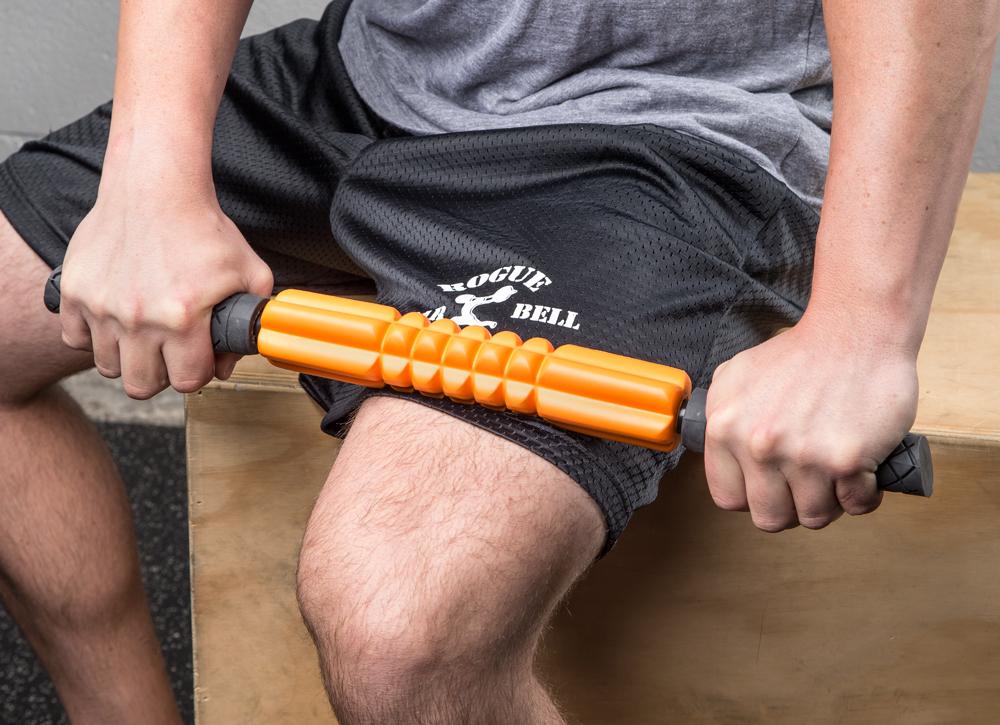
Product Highlights
- Textured grooves dig deep into muscle tissue
- Not painful
- Up to 500-lb weight capacity
- Compression resistance
Pros & Cons
Pros
- Texture digs into soft tissue, but not to the point of pain
- 500 lb weight capacity
- High-density foam and rigid plastic core will resist compression
Cons
- 5” diameter is too thick for rolling feet
- Not super travel-friendly
Bottom Line
The textured grooves help to dig deep into muscle tissue to alleviate pain.
This is as good as foam rollers get in my opinion. I think the Trigger Point Grid foam roller provides the perfect amount of pressure: It doesn’t have a smooth surface but it’s not painful like the Rumble Roller, which has knobby thumb-like bumps.
I suppose it depends on what you want, but I like foam rolling sessions to feel good and productive—I don’t want to be wincing in pain the whole time.
On sore muscles, the Grid is perfect; on recovered/not sore muscles, I sometimes feel like I have to dig in quite hard, but I’d prefer that over a roller where I feel like I can’t apply force or simply lie on it.
At 13 inches long, this foam roller is more than adequate for full-body rolling and the rigid, hollow plastic core is a good defense against permanent compression. The 5.5-inch diameter is perfect for rolling all muscle groups, except the arches of your feet (it’s a little too big for that).
It’s lightweight and easy to move around, but this isn’t a mini foam roller, so don’t expect it to be uber-easy to travel with. It will take up a good amount of space in any bag or suitcase.
All foam rollers will compress some over time, but Trigger Point historically makes foam rollers that last for what seems like forever. I’ve had the same Grid foam roller for over five years. The outer layer is made of EVA foam, which is what the midsole of most running shoes is constructed of, so you can trust that it will resist getting smushed due to your body weight. It also has a 500-pound weight capacity, and few users will come close to meeting that.
RELATED: How to Choose Running Shoes
For $35, this is one of the best recovery tools you can buy. Trigger Point is a big name in the space for a reason: They make good stuff. This particular roller has been on Amazon since 2009 and is to date a best seller, so that should say enough.
Best Vibrating Foam Roller: Theragun WAVE
Good for: People who love to blend the traditional with the new wave (see what I did there?).
Best Vibrating Foam Roller
Theragun WAVE
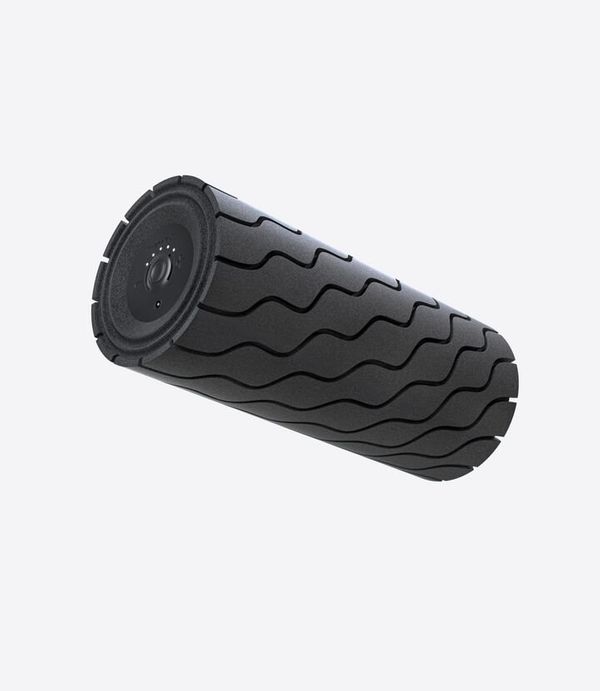
Product Highlights
- 5 vibration settings/speed levels
- Comes with a bag for traveling
- 12 inches long; great for full-body rolling
Pros & Cons
Pros
- Bluetooth connectivity
- Waved texture
- 5 vibration settings
- Access to a library of recovery routines
Cons
- Users report vibration can be heard through the floor
- Reportedly not as firm as a traditional foam roller
Bottom Line
The Theragun WAVE is a fantastic recovery tool that brings a new level of intensity to foam rolling.
Honestly: meh. I wasn’t overly impressed with the Theragun WAVE, but I wasn’t overly impressed with any other vibrating foam roller options, either. Of what’s available, I think the WAVE provides the best bang for your buck.
It’s got five vibration settings/speed levels, but it’s important to remember that this is a vibrating foam roller, not a percussive therapy device. Despite the fact that it’s a Therabody product, it does not work like a Theragun and you shouldn’t expect it to. The “innovative wave texture” doesn’t do anything in my opinion. It just feels like a smooth-surfaced foam roller.
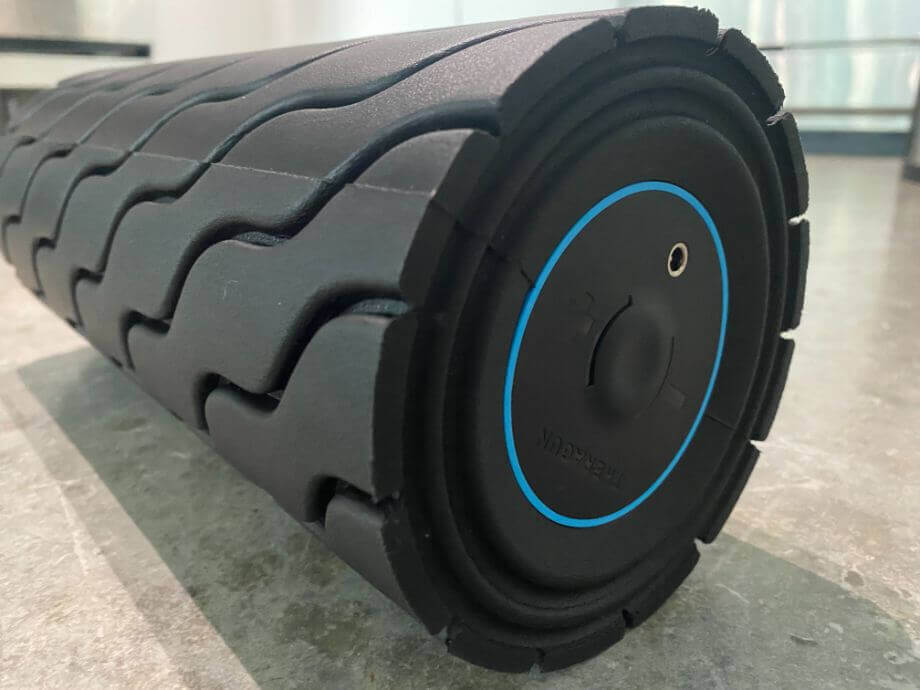
I’m not totally sure the vibration adds anything on top of the benefits a regular foam roller brings, especially because the WAVE has a flat surface rather than a bumpy surface that can dig into the muscles. Also, I’m pretty sure you can hear this thing through the floor if you live in an apartment, which is not ideal. That’s not a flaw to just the WAVE, though, as this would be the case with any vibrating roller.
It’s made of high-density polyurethane foam, so it should last and avoid permanent compression like some cheaper foam rollers. The outer material is ethylene-vinyl acetate (EVA) foam, and is hypoallergenic according to Therabody, which is a nice bonus for those worried about skin irritation.
I mean, all in all, it’s a foam roller. It’s well-constructed and 12 inches in length, so it works for full-body rolling.
It comes with a nice canvas pouch to hold the roller and the charging cable. It weighs a little over 3 pounds and has a battery life of 3 hours, both of which make this a decently travel-friendly option.
I’m torn on novelties like vibrating foam rollers because they are cost-prohibitive for so many people and I personally think a regular foam roller that doesn’t cost over $100 works just fine. In comparison to other vibrating rollers on the market, the Theragun WAVE provides more value by having more speed settings and coming with travel-friendly accessories.
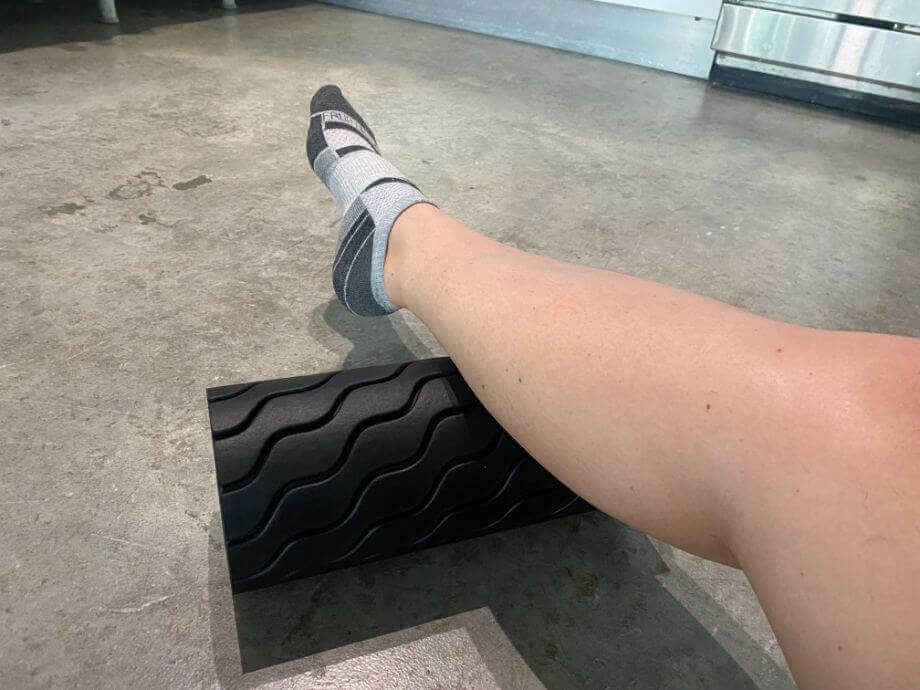
Best Foot Roller: Power Plate DualSphere
Good for: People who need to dig deep into specific pain points.
Best Foot Roller
Power Plate DualSphere
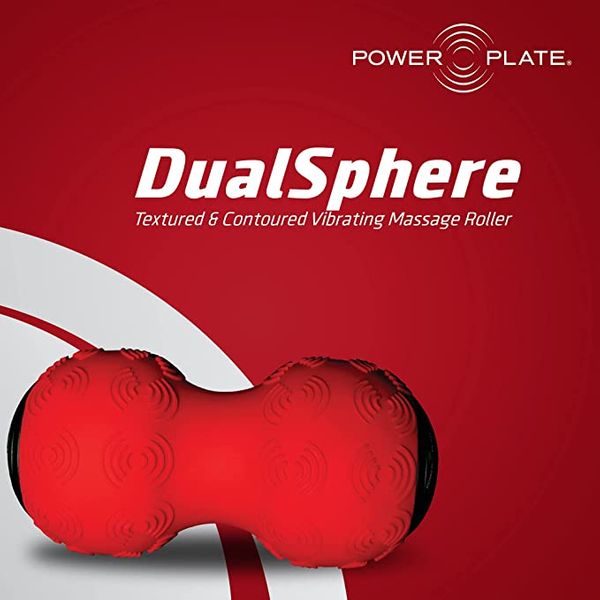
Product Highlights
- Contoured shape digs into muscles from multiple angles
- Textured surface prevents it from rolling around
- Four vibration speed settings
- Amazing for feet, calves, and neck
Pros & Cons
Pros
- Contoured shape digs into muscles from multiple angles
- Textured surface prevents it from rolling around
- Four vibration speed settings
- Amazing for feet, calves, and neck
- 3-hour battery life
- USB-C charging
Cons
- First speed setting is hardly noticeable
- Doesn’t come with a carrying case
- This is a vibration massager, not a percussion massager
Bottom Line
The PowerPlate DualSphere is a travel-friendly contoured massager that works wonders on the feet, as well as the calves and back.
This is my top pick for “best foot roller,” because it works wonders on the arches, but it’s a great tool for more than just your feet.
The DualSphere provides a good blend of manual power and vibration. Due to the contoured shape you don’t actually even need the vibration to get a good massage. The “peanut” shape digs into muscle tissue from different angles. The vibration is an added bonus if you want it, and there are four speeds to choose from.
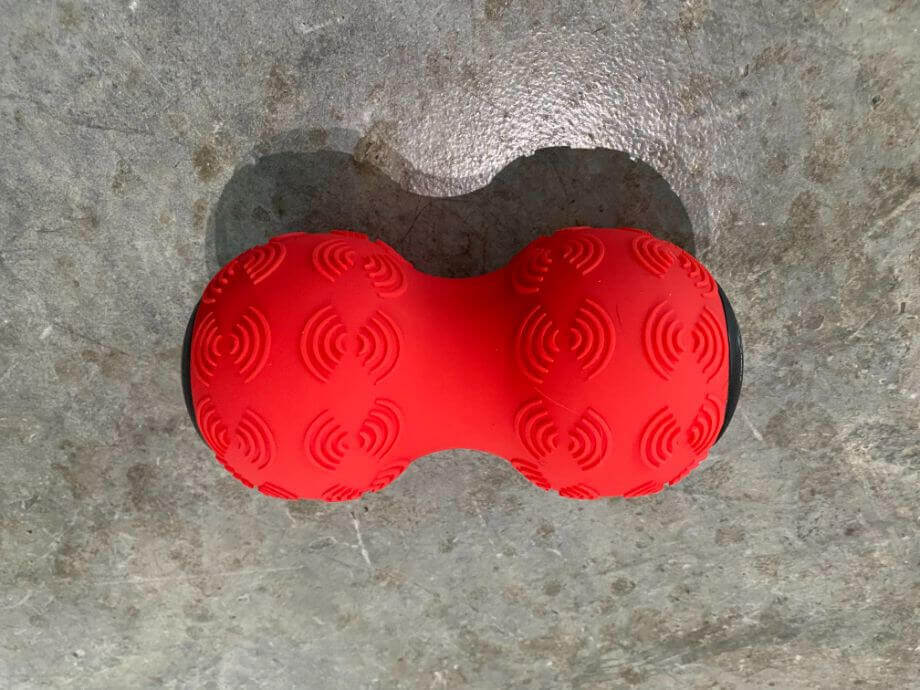
I enjoyed using the DualSphere on my feet, calves, glutes, hamstrings, lower/mid/upper back, traps, and neck. It’s amazing for sore feet—it’s been an absolute lifesaver for me in the midst of triathlon training, when I’m running about 25 miles per week and biking 60 to 70 miles per week.
It also works phenomenally well along the spine, including the neck, so it’s much more than just a foot roller and will relieve muscle soreness throughout the whole body.
I will say the DualSphere is a little hard to maneuver when using it on the upper back. I found myself wiggling a lot to keep it in place between the shoulder blades, but that’s the only time I had trouble. Otherwise, the contour is amazing and I love that it massages muscles from multiple angles. Especially for the feet—it hits the arch and the outside of your foot at the same time, which is awesome.
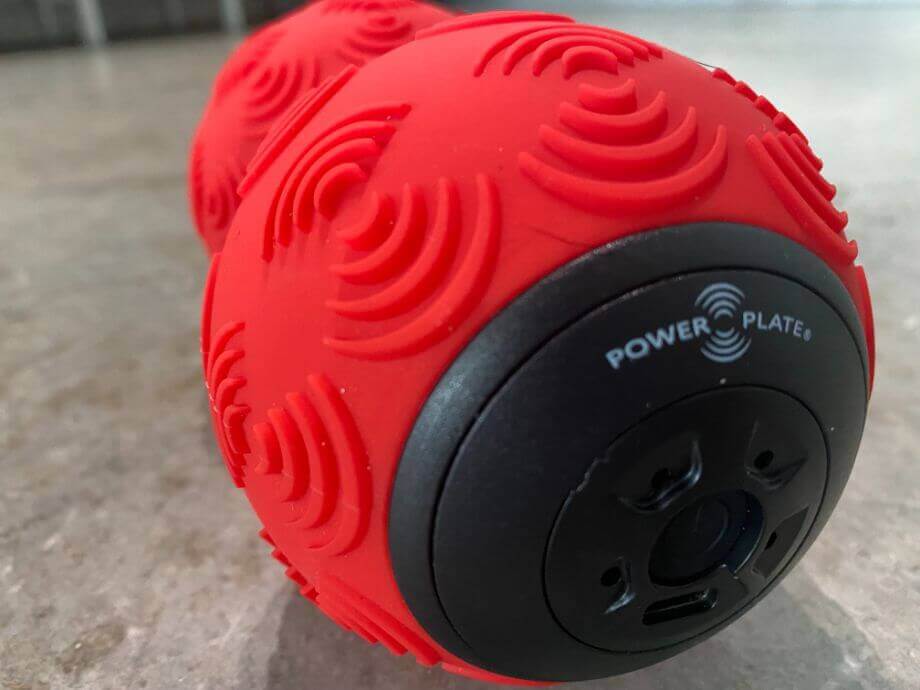
The three-hour battery life is on par with other similar massage rollers.
The DualSphere seems durable: It has a really hard core and no actual foam, so it’ll resist compression unlike a true foam roller. The textured outer is made of a rubber compound.
One of my favorite things about the DualSphere? It’s pretty small and packable. The dimensions are 8.82 inches long by 6.18 inches high by 3.98 inches wide, and it weighs under 2 pounds. You can easily toss it into a backpack, gym bag, carry-on, or whatever. I do wish it came with a drawstring bag to keep the charger and device together, but that’s me being nitpicky.
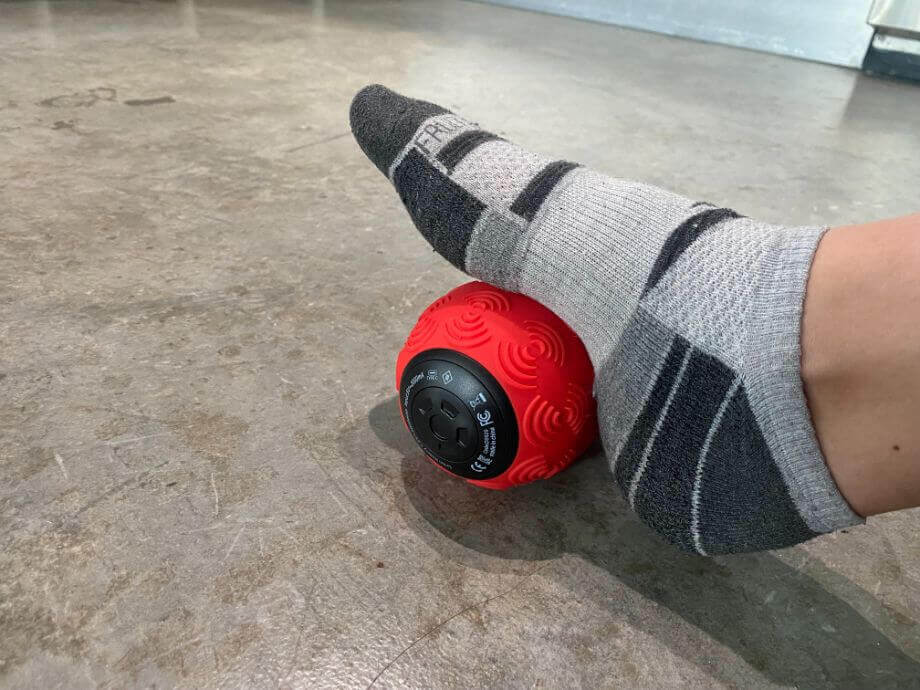
Best Electric Muscle Stimulator (EMS Device): Compex Sport Elite 2.0
Good for: People who want supreme versatility in an e-stim device.
Best EMS Device
Compex Sport Elite Stimulator 2.0
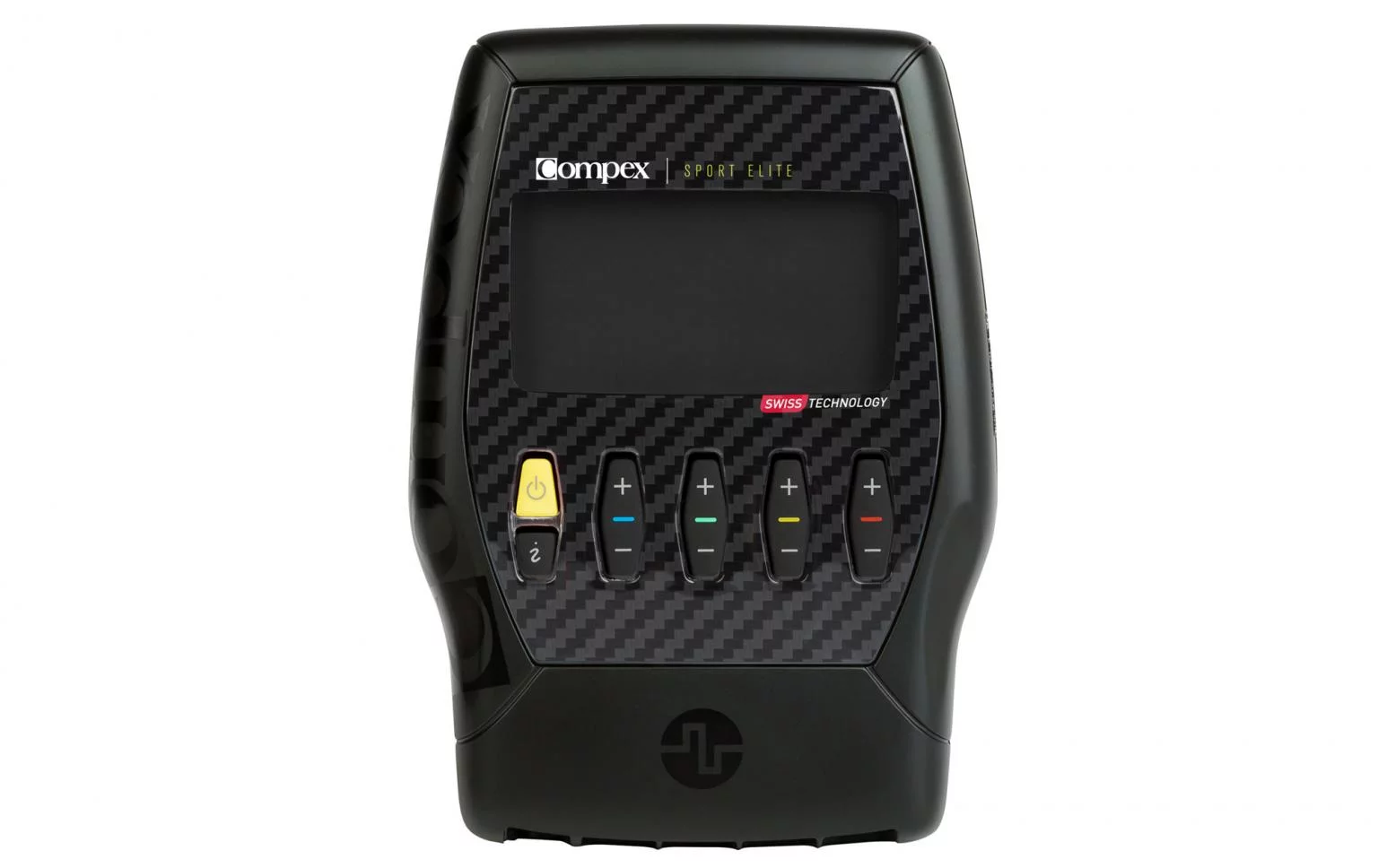
Product Highlights
- Uses EMS and TENS
- 10 different programs
- Multiple progression levels
- 12 stick electrodes
- FDA-cleared
Pros & Cons
Pros
- 10 different programs (EMS and TENS)
- Each program has 5 progression levels
- Comes with 12 sticky electrodes
- FDA-cleared device for chronic pain relief
Cons
- Cords are long and can get unwieldy
- Doesn’t arrive charged
- Hard to maximize use on your own (helpful to have a friend place the electrodes)
Bottom Line
A versatile and trusted e-stim device for muscle recovery.
Electric muscle stimulation (EMS) is a type of physical therapy that sends electrical currents through your soft tissue, including skin, fascia, and muscle tissue. These currents are thought to block pain signals from the body to the brain, enhance blood circulation, and potentiate muscle fibers, which means to increase performance or strength.
The Compex Sport Elite 2.0 has 10 programs and five levels of progression, meaning it has something for everyone in every stage of the muscle recovery journey. You can use the lower settings when you’re really sore and bump it up when your muscles aren’t as tender.
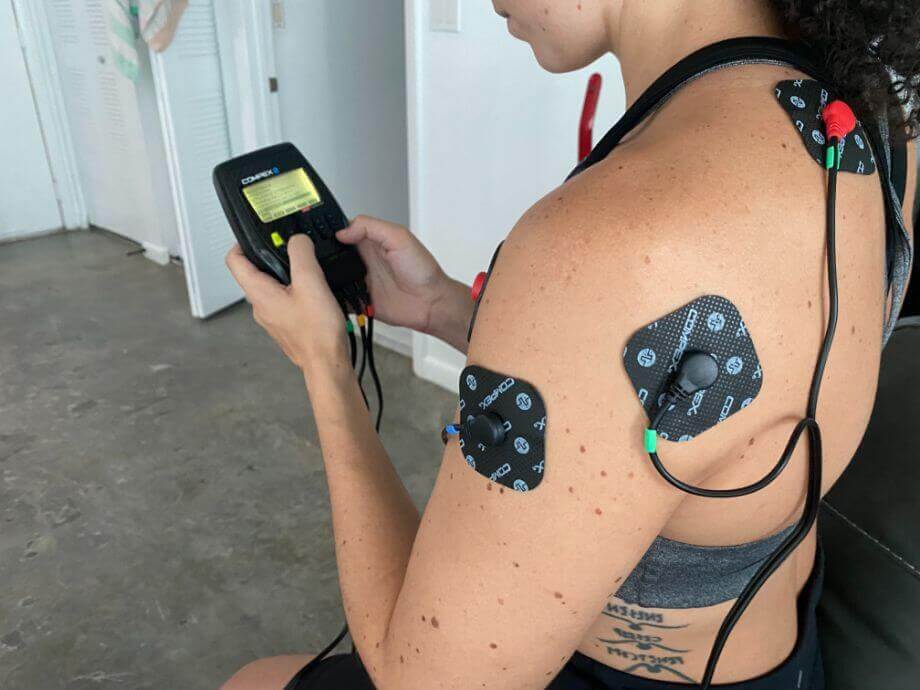
This particular Compex device offers both EMS and transcutaneous electrical nerve stimulation (TENS), which are two different therapies. Between that, the 10 programs to choose from, and five progression levels, there’s a lot of versatility packed into one device.
Once you get everything set up, the Compex is easy to use. The controls on the device are simple and easy to read. However, setup is a bit of a hassle (but that’s true for every e-stim device). There are just lots of cables and getting the sticky electrodes on can be a pain, especially if you’re trying to use the device on your back.
It helps to have someone around to stick them on in the right place and attach the wires. It’s definitely doable on your own, but I did experience some frustration. Compared to PowerDot, I like the Compex better thanks largely to the longer wires. This makes it easier to adjust without pulling the cables off of the electrodes.
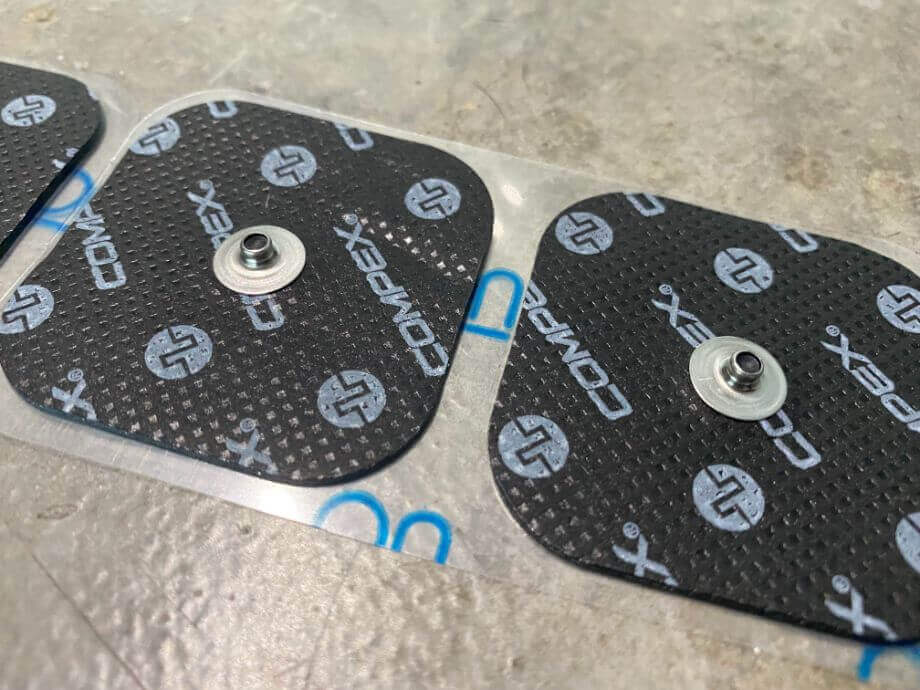
As far as EMS devices go, the build quality feels average. The controller is made of plastic, but it shouldn’t be a concern unless you’re throwing the device around. It has an LCD display. The wires are coated in rubber and the sticky electrode pads are thick, so they should last a long time before you have to reorder.
I like the electrode pads on Compex more than on any other e-stim device I’ve tried. They’re also much stickier than those that come with PowerDot units; I had no issue with them peeling up or slipping.
The Compex Sport Elite 2.0 comes with a soft drawstring bag to place control, cables, charger, electrodes, and guides inside. All in, it weighs just a couple of pounds and can easily fit in a backpack.
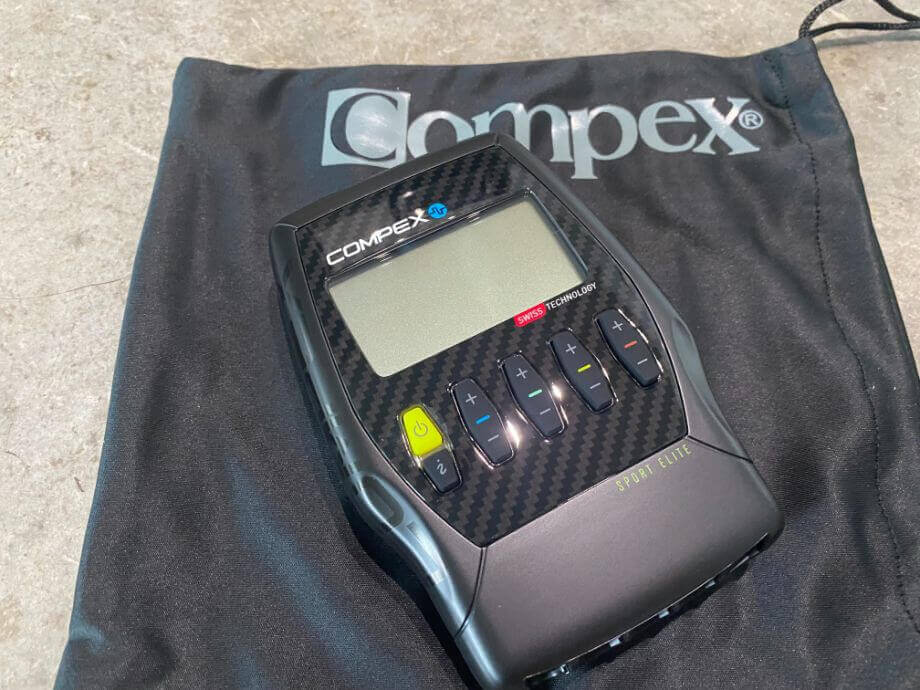
Best Muscle Rub: Tiger Balm
Good for: People who want near-instant relief from sore muscles.
Best Muscle Rub
Tiger Balm
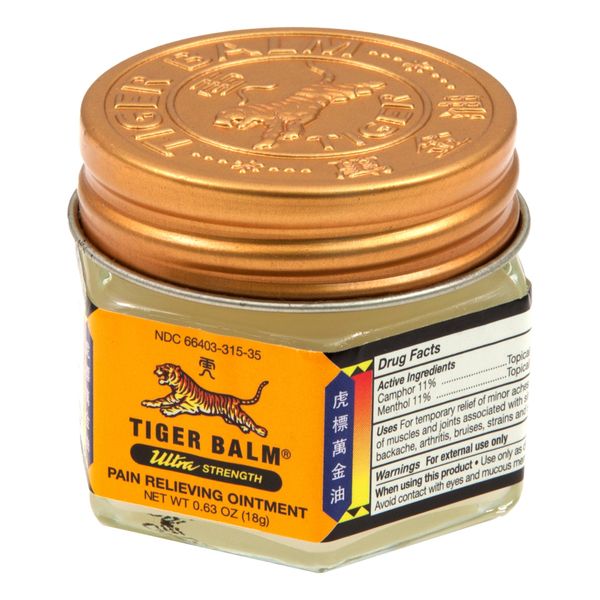
Product Highlights
- Provides quick relief
- Comes in a variety of options (cream, gel, spray, patches)
- Provides a cooling sensation
Pros & Cons
Pros
- Effective for short-term pain
- Used for over 100 years
- 18 products to choose from
- Affordable
- Fast-working
- Lasts for several hours
Cons
- Some forms stick to fingers
- Strong smell
Bottom Line
If you're looking for fast and long-lasting relief from arthritis or other muscular pain, Tiger Balm is sure to have a product for you.
I loved Tiger Balm before even trying it thanks to their slogan: “Pain Happens. Suffering Is Optional.”
Marketing aside, this stuff is really bonkers—in a good way. There are so many topical analgesics to choose from, and it can be really daunting to pick one when so many have the same active ingredients.
The active ingredients in Tiger Balm include camphor and menthol. Camphor is a waxy, transparent terpene (an aromatic compound found in plants) that’s been used for centuries as an analgesic. Like menthol, which is another terpene, camphor produces a cooling sensation on the skin.
Tiger Balm’s formula also includes a few other plant oils, but camphor and menthol are the two active ingredients that produce the warm-then-cool tingling sensation associated with topical pain relief.
I prefer Tiger Balm over other muscle rubs because it seems to work faster and last longer. Also, I tend to get more use out of a small tin of Tiger Balm than a tube of IcyHot or Biofreeze—a little bit of Tiger Balm goes a very long way.
Thanks to the additional plant oils in the formula, Tiger Balm has a subtler smell than a topical pain reliever made with just menthol and, say, glycerin and water.
Best Recovery Tool for Runners: Dimple Ball
Good for: People who want something simple and portable, but still effective.
Best Recovery Tool for Runners
Dimple Ball
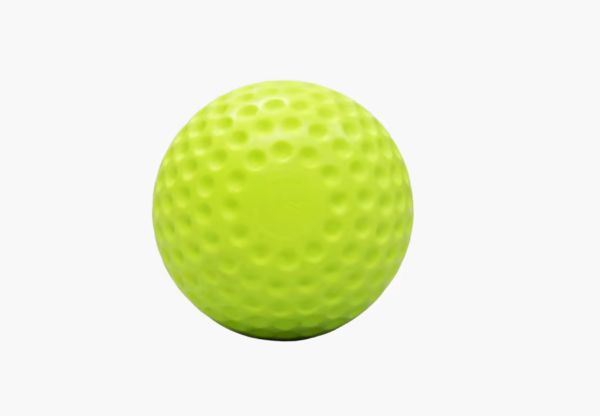
Product Highlights
- Inexpensive
- Slightly bigger than a typical lacrosse ball
- Textured surface means it won’t roll away
Pros & Cons
Pros
- Slightly bigger than a lacrosse ball
- Affordable
- Easily tossed in your gym bag or backpack
- Bright neon green color makes it highly visible
Cons
- Some reviews reported that it left imprints in the form of bruises
- A bit slippery if you’re sweaty or wearing certain fabric types
Bottom Line
The Dimple Ball is a portable mobility and recovery tool available at a very reasonable price. It’s versatile, portable and highly effective.
Massage balls represent the birth of muscle mashing as it relates to functional fitness. If you walked into any CrossFit gym between 2010 and 2015—and probably still if you walk into one today—you’d find a bucket of lacrosse balls.
Lacrosse balls are a simple but effective tool. They’re inexpensive and portable, and they don’t require a battery or use of a motor. Due to their size and density, lacrosse balls can dig deeply into soft tissue.
The Dimple Ball is similar to a lacrosse ball, but it’s slightly larger and has a textured surface. I find the larger diameter to make rolling the upper back and glutes more comfortable, as it disperses the pressure across a larger surface area. The dimpled surface means it won’t roll away while you change positions or take a break.
Depending on the finish of your flooring or wall paint, the Dimple Ball may slide around beneath your body a bit more than you anticipate. Also, beware of loose head hair and body hair, as the rubbery texture may pull at it. I usually wear a tight tank top or t-shirt while rolling with the Dimple Ball, because it prevents hair-pulling and loose clothing can get bunched up beneath the ball.
I love this tool because the intensity of the massage is totally up to you: Whether you’re lying on the Dimple Ball or sandwiching it between your body and a wall, you control the depth of the massage.
Just keep in mind: If you’ve never performed muscle-mashing with a lacrosse ball or similar tool before, you may experience minor bruising as a result of increased pressure and blood flow to the treatment site. Take care not to re-roll over bruises before they’re fully healed.
Other Muscle Recovery Tools We Researched
In addition to all of the products we recommend as the best recovery tools, there are plenty of others we’ve tested and researched. Here are several that didn’t make the list, but deserve a shout-out.
Massage Guns
Our team has collectively tested dozens of massage guns. This section briefly rounds up some massage guns we considered for inclusion in our guide to the best recovery tools.
Theragun Models
Theragun makes the most powerful massage guns available directly to consumers, no doubt. You can’t argue with the specs, and that’s why Theragun consistently tops our lists related to workout recovery tools.
Read our full Theragun review of all four models to learn more.
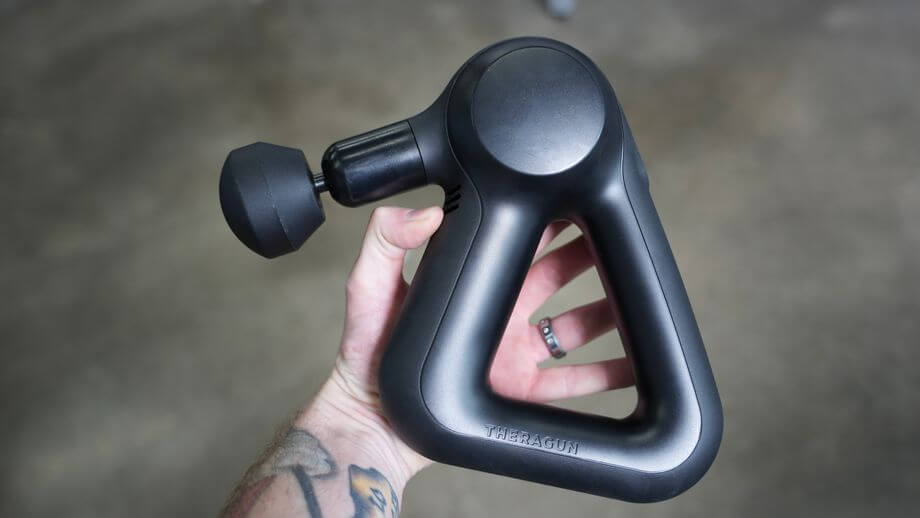
Hypervolt Models
Hypervolt is the most prevalent Theragun competitor, and Hypervolt massage guns are good—but not as good as Theraguns, which you can objectively see in our Theragun vs. Hypervolt in-depth comparison.
To learn more about Hypervolt models, read our full Hyperice Hypervolt review and Hypervolt Go review.
More Massage Guns
Our team has extensively tested nearly 50 massage guns, and we round up our favorites—plus more than 20 models that didn’t make the cut—in our best massage guns roundup. There, you’ll also find an in-depth massage gun buying guide.
Compression Boots
Pneumatic compression suits have become more popular in recent years thanks largely to NormaTec’s partnerships with college and professional sports teams, which brought this type of therapy into the mainstream. What was once reserved for elite athletes and hospital patients (yup, pneumatic compression was originally used for blood clot prevention and lymphatic drainage) is now available to anyone.
Compex Ayre Wireless Recovery Boots
Compex makes great EMS devices, but I haven’t tested the brand’s compression boots, so I can’t say for sure how these work. I’d love to get my hands on them, because the specs look great: 3-hour battery life, compression up to 120 mmHg, compact carrying case, wireless control unit, and four compression chambers that can be filled independently or simultaneously.
Therabody RecoveryAir JetBoots
Therabody acquired RP Sports, a manufacturer of pneumatic compression devices, in November 2020. I’ve used the JetBoots and, while they work well, they’re lacking in one key department compared to the NormaTec boots: the JetBoots have four compression levels versus NormaTec’s seven.
Rapid Reboot Recovery System
I haven’t tried these compression boots, but Rapid Reboot is a pretty big brand name in pneumatic compression. My first impression: inclusive sizing! These are the only compression boots to my knowledge that come in more than three sizes. Rapid Reboot offers sizes XS, S, M, L, and XL. These boots feature 10 compression settings, four chambers, and a seamless interior.
Foam Rollers
There are quite literally hundreds of foam roller options out there, and many of them are identical aside from branding. Here are a few other notable foam rollers we researched and tested, but didn’t make the list.
Hyperice Vyper Go
Coop has a Hyperice Vyper Go and loves it. The contour is what sets this vibrating foam roller apart from others. It’s smaller than the Theragun WAVE, with a length of 10.6 inches, but you may find it digs into the muscles more thanks to the contour. The Vyper Go has three vibration settings and a 2-hour battery life.
Hyperice Vyper 3
This is Hyperice’s full-sized vibrating foam roller. It’s slightly larger than the Theragun WAVE at 13 inches in length, but it has fewer speed settings (three, just like the Vyper Go). It has a slight contour compared to the WAVE, which isn’t objectively better or worse.
Rumble Roller
This wouldn’t be a guide to workout recovery tools without including the Rumble Roller. This foam roller has been around since the beginning of the foam rolling movement. You’re likely to find one in any CrossFit gym you step foot into. The Rumble Roller features thumb-like bumps on the surface that dig into muscle tissue—and I mean really, really dig. That’s precisely why it’s not my top pick for foam rollers: Although it works, I believe it’s too painful for most people to use consistently.
EMS Devices
Most consumer EMS devices are pretty similar, but here are two popular ones aside from the Compex we think are worth calling out.
Marc Pro
Coop’s a big fan of the Marc Pro. In fact, it’s his favorite EMS device, but I’ve extensively used the Compex and have had great results—and the Compex Sport Elite 2.0 costs much less than both Marc Pro models. The original Marc Pro costs $700, while the Marc Pro Plus costs $1,400. The Compex Sport Elite 2.0 costs less than $500 and is often on sale for 20 to 40% off.
PowerDot 2.0
The PowerDot 2.0 comes with all the bells and whistles: Bluetooth connectivity, in-app control, and personalized recovery protocols. However, there’s one thing stopping the PowerDot 2.0 from being my favorite EMS device—the cords are hella short. I find myself getting frustrated when using the PowerDot because the electrodes and corresponding wires are difficult to adjust.
Muscle Rubs
There are tons of muscle rubs and topical pain relievers available over-the-counter at any local drugstore. Most of them use a combination of the same ingredients as Tiger Balm, my favorite muscle rub, but here’s a quick look at why these didn’t make the top list.
IcyHot
IcyHot is a staple name in the muscle recovery space. The main ingredient in the IcyHot formula is menthol, versus the camphor in Tiger Balm. I like IcyHot and have used it plenty of times, but in my opinion, the “hot” part of IcyHot can actually be too intense and somewhat painful. Still, it’ll temporarily relieve muscle pain.
Biofreeze
Biofreeze is another topical pain reliever that includes menthol as the main ingredient. It works well enough and feels similar to Tiger Balm in use. However, I found Biofreeze to have a stronger smell than Tiger Balm, which is why I didn’t choose it for the top picks list.
Penetrex
Penetrex is unique in that it’s a topical pain relief cream that doesn’t include menthol—thus it doesn’t produce the typical smell associated with these creams. The active ingredients are arnica, vitamin B6, glucosamine, and methylsulfonylmethane (MSM), which is touted as a pain reliever for arthritis—although evidence is scarce. Penetrex is really expensive compared to Tiger Balm, at about $20 for 2 ounces, compared to Tiger Balm’s approximate $10 to 2 ounces. Prices change often, though, so keep an eye out for sales.
How We Picked and Tested
Every item that appears on the top list in this guide has been in my hands. Not only have I thoroughly analyzed specs and customer reviews of these products, but I have actually used them in my own home after and in between workouts to speed up recovery and relieve muscle tension.
And trust me—I need them. I wrote this article at the peak of a 12-week triathlon training program, so during my testing of these products, I was able to fully understand how they helped. Across product categories, I was looking for specific scenarios: trigger point relief, mobility improvements, decrease in soreness, performance enhancement, or simply temporary pain relief so I could get some sleep.
I incorporated these items into my routine over the course of several weeks and took detailed notes throughout the process so I could bring this guide to you.
Why You Should Add Muscle Recovery Tools to Your Home Gym
Workout recovery is just as important as working out itself. Every avid exerciser should have a dedicated muscle recovery routine, whether it consists of using specialized tools or not.
Although I tend to adopt a “less is more” attitude when it comes to workout recovery—I love a good lacrosse ball and stretching session—I do geek out over gear and I think it can help many people feel more motivated to consistently prioritize recovery.
I mean, a post-workout massage is generally more enjoyable than doing post-workout mobility drills, even if it’s by way of a percussive device.
Aside from the fact that dedicated recovery tools make the process feel less complex and intimidating, they also offer targeted relief. As good as stretching and walking are, these modalities can only do so much—they can’t loosen up a trigger point like a massage gun or electrically block pain signals like an EMS device.
Best Muscle Recovery Tools Buying Guide
Quite frankly, there are so many muscle recovery tools out there that the average person would tire of sorting through them all.
So, it’s helpful to start with a specific modality in mind—someone interested in “muscle mashing” (AKA myofascial release) needn’t concern themselves with muscle rubs or EMS devices.
Here, I break down how to search for the best muscle recovery tools in four different categories.
For Self-Myofascial Release
Self-myofascial fascial release is a type of soft-tissue therapy that intends to break up adhesions, or spots of tense tissue, in the fascia.
Fascia is a type of connective tissue “webbing” that exists all throughout the body and helps keep muscles, bones, tendons, ligaments, and organs in place. It can become tight and painful, resulting in a feeling of soreness, and manual manipulation can provide some relief.
Helpful SMR tools include:
- Foam rollers and vibrating foam rollers
- Massage guns
- Roller sticks
- Other rolling tools, like the Roll Recovery R8
- Massage balls (like the Dimple Ball we recommend above)
Tools with motors (like massage guns) or springs (like the Roll Recovery R8) produce more power, and thus penetrate tissues more deeply, than regular foam rollers, massage balls, and sticks. For more information on self-myofascial release, read our guide to foam rollers vs. massage guns.
For Compression
Compression therapy is an age-old tactic for manipulating blood circulation as well as reducing fluid retention and inflammation in the limbs, although compression stockings used to dominate the market. These days, if you search “compression for muscle recovery” in Google, the web will spit back a slew of mechanical compression boots like the NormaTec boots I described above.
If you’re interested in adding compression boots (or entire compression suits) to your workout recovery routine, these basic specs should be part of your search:
- Multiple compression levels
- Segmented compression (meaning the boots have seams and the chambers fill with air in a pattern)
- At least a two-hour battery life on the control unit
- A carrying case
- Boots constructed of an easy-to-clean and durable material, like a thick nylon blend
Oh, and if you’re not quite ready to drop $500 to $1,000, compression socks and wraps can get you through in the meantime.
For Hot/Cold Therapy
Applying heat and/or coldness to your muscles is a great way to increase or constrict blood flow, respectively, both of which can enhance muscle recovery.
Using temperature as a muscle recovery tactic can be really inexpensive or very pricey. For example, muscle rubs that produce heating and cooling sensations on the skin don’t cost very much money and can be a fantastic way to distract you from muscle pain. Heating pads and wraps and cold showers don’t cost much, either.
However, things like whole-body cryotherapy (WBC) and fancy ice bath tubs (like The Cold Plunge, which we’re working on getting set up at our Springfield, Missouri, fitness testing center) cost more than the average exerciser is willing to spend.
It all comes down to budget, so the best way to approach this is to choose a product in your budget that works with your lifestyle. For instance, if you need something portable, a muscle rub or heating pad is a good option.
Disclaimer: Please don’t use heat on injuries such as muscle strains, sprains, bruises, or wounds. When heat is applied to the body, it increases blood circulation, which may cause more swelling around an existing injury. Contact your doctor about any therapies related to an injury.
For Electric Muscle Stimulation
Electric muscle stimulation, or e-stim, is a type of physical therapy that sends electrical currents through your body’s soft tissues (such as skin, fascia, and muscle tissue) to increase blood circulation, block pain signals, decrease muscle spasms, and increase muscle strength.
Consumer e-stim devices are passive, meaning you apply the electrodes and then sit or lie down while the machine works. If you’re interested in buying an e-stim device such as the Compex Sport Elite 2.0, our top pick, here are some specs to look for:
- Multiple programs, such as for recovery, pain relief, and performance enhancement
- Several progression levels to account for soreness level and pain tolerance
- Multiple current types, such as TENS, neuromuscular electrical stimulation (NMES), and/or interferential current (IFC)
- Cords that don’t tangle
- Many included electrodes and an easy way to reorder them
- A carrying case or bag to hold all of the components
- A battery life of at least two hours
FAQs
Commonly asked questions about muscle recovery are:
What is the best way to recover from a workout?
There are a lot of good ways to recover from workouts. Some of the best ways to incorporate workout recovery are: stretching, foam rolling, using a percussion massager, cold-plunging, making sure to eat a nutritious meal, hydrating plentily, and getting a good night’s sleep. It’s important to remember that workout recovery doesn’t have to be drawn out or complex. A routine as simple as a short walk to keep blood flowing and a post-workout protein shake can help tremendously.
What should you not do after a workout?
While there’s no one best way to recover from a workout, there are a few things you shouldn’t do after a workout. Don’t skip meals; don’t immediately become sedentary; and don’t forget to rehydrate.
What helps muscles recover faster?
Proper nutrition and hydration, plenty of sleep, and maintaining blood circulation are three keys to quick muscle recovery. After a workout, your body needs replenishment, primarily in the form of carbohydrates, protein, fluids, and electrolytes. During sleep, the body produces important hormones that assist in the muscle repair and muscle growth processes. Finally, maintaining blood circulation after a workout helps your body deliver essential nutrients and oxygen to depleted muscles.
Further reading
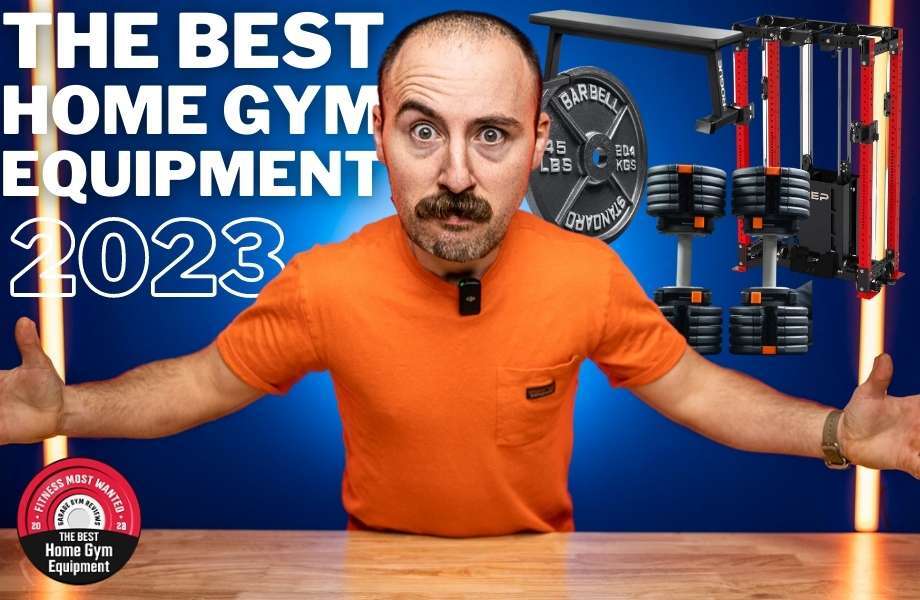
We researched and tested equipment, programs, and supplements across the industry to find the very best of the best. Find out what we think is hot this year. Read more
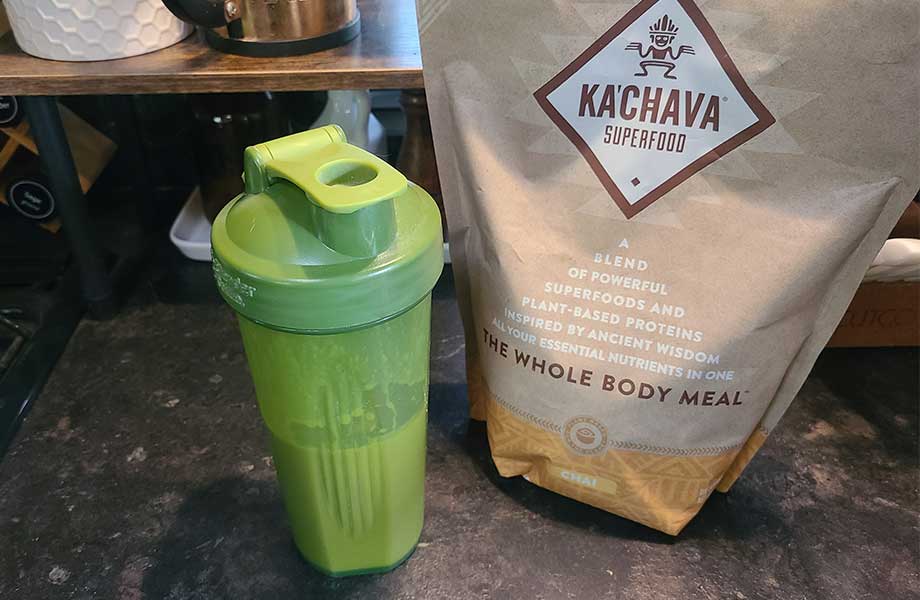
In this Ka’Chava review, we’ll give you all the details from testing out this meal replacement shake firsthand. Read more
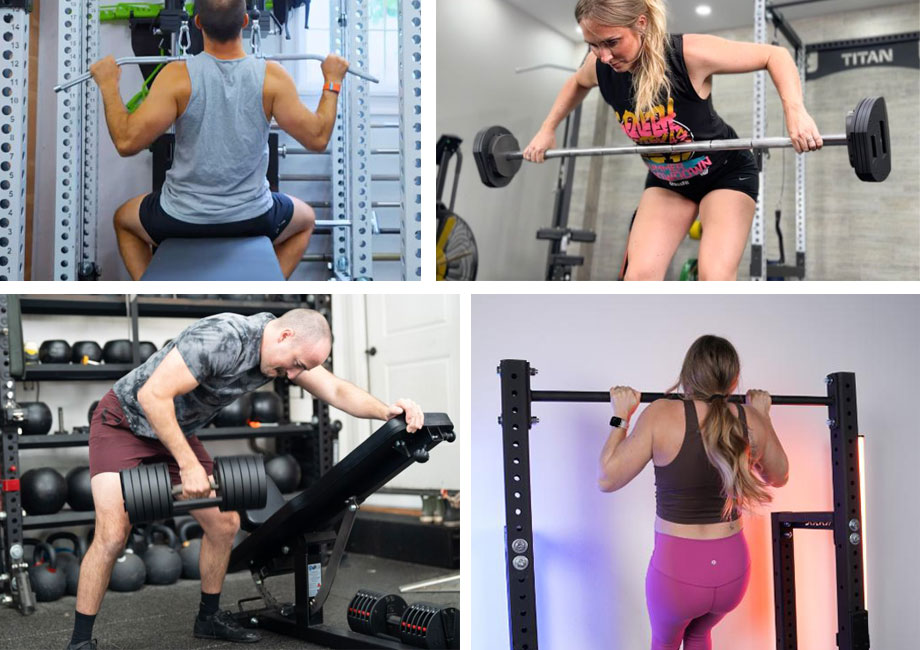
If you’re looking to sculpt your back, but just can’t find a way to build the bottom of your lats, try these 10 lower lat exercises to build a bigger back. Read more
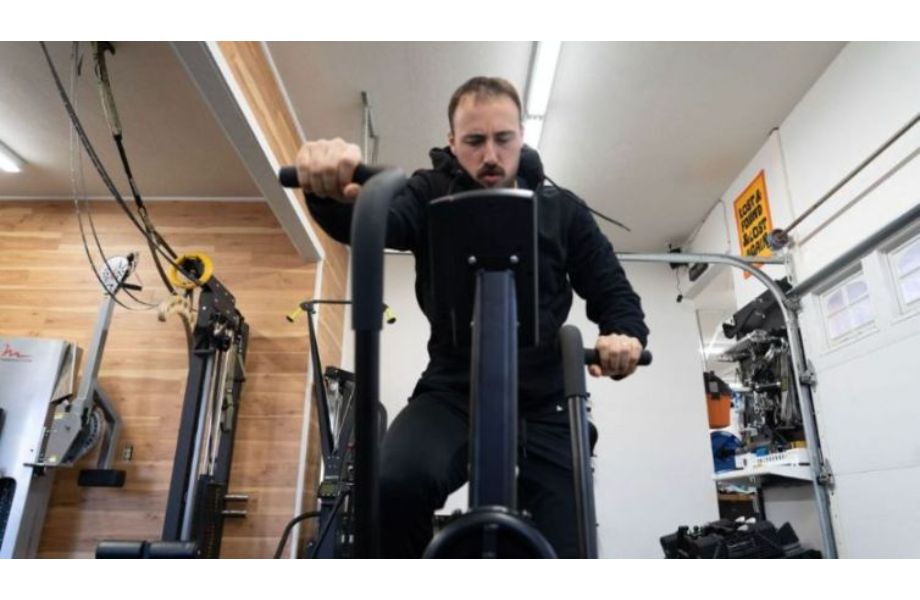
Our Garage Gym Reviews team set out to find what home workouts people love the most, what states are working out from home more often, and which have the biggest online communities for you to learn from. We analyzed data looking at the most-loved workouts and dug into what states are searching for home workout terms the most. Read more

